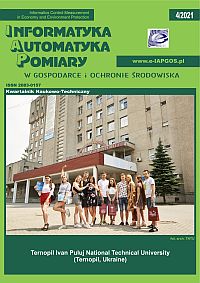CHROMATIC DISPERSION COMPENSATION IN EXISTING FIBER OPTIC TELECOMMUNICATION LINES WITH THE GROWING BIT RATES NEEDS OF DWDM SYSTEM
Article Sidebar
Open full text
Issue Vol. 11 No. 4 (2021)
-
SINGULAR INTEGRATION IN BOUNDARY ELEMENT METHOD FOR HELMHOLTZ EQUATION FORMULATED IN FREQUENCY DOMAIN
Tomasz Rymarczyk, Jan Sikora4-8
-
APPLICATION OF THE THREAT INTELLIGENCE PLATFORM TO INCREASE THE SECURITY OF GOVERNMENT INFORMATION RESOURCES
Bohdan Nikolaienko, Serhii Vasylenko9-13
-
INDIRECT INFORMATION HIDING TECHNOLOGY ON A MULTIADIC BASIS
Volodymyr Barannik, Natalia Barannik, Oleksandr Slobodyanyuk14-17
-
SELECTED APPLICATIONS OF DEEP NEURAL NETWORKS IN SKIN LESION DIAGNOSTIC
Magdalena Michalska18-21
-
EFFICIENT LINE DETECTION METHOD BASED ON 2D CONVOLUTION FILTER
Paweł Kowalski, Piotr Tojza22-27
-
FACTOR ANALYSIS METHOD APPLICATION FOR CONSTRUCTING OBJECTIVE FUNCTIONS OF OPTIMIZATION IN MULTIMODAL TRANSPORT PROBLEMS
Serhii Zabolotnii, Artem Honcharov, Sergii Mogilei28-31
-
QUALITY OF SATELLITE COMMUNICATION IN SELECTED MOBILE ANDROID SMARTPHONES
Przemysław Falkowski-Gilski32-37
-
CHROMATIC DISPERSION COMPENSATION IN EXISTING FIBER OPTIC TELECOMMUNICATION LINES WITH THE GROWING BIT RATES NEEDS OF DWDM SYSTEM
Tomasz Bobruk38-41
-
FIBRE OPTIC BRAGG STRUCTURES WITH MONOTONIC APODISATION CHARACTERISTICS
Jacek Klimek42-46
-
ON THE CAPACITY OF SOLAR CELLS UNDER PARTIAL SHADING CONDITIONS
Mateusz Bartczak47-50
-
CONTROLLING A FOUR-WIRE THREE-LEVEL AC/DC CONVERTER WITH INDEPENDENT POWER CONTROL IN EVERY PHASE
Bartłomiej Stefańczak51-54
-
METHOD OF MEASUREMENT AND REDUCTION OF THE ELECTROMAGNETIC DISTURBANCES INDUCTED BY SWITCHING SURGES IN LV CIRCUITS
Patryk Wąsik55-61
-
INCREASING THE COST-EFFECTIVENESS OF IN VITRO RESEARCH THROUGH THE USE OF TITANIUM IN THE DEVICE FOR MEASURING THE ELECTRICAL PARAMETERS OF CELLS
Dawid Zarzeczny62-66
-
ELLIPSOMETRY BASED SPECTROSCOPIC COMPLEX FOR RAPID ASSESSMENT OF THE Bi2Te3-xSex THIN FILMS COMPOSITION
Vladimir Kovalev, Saygid Uvaysov, Marcin Bogucki67-74
-
APPLICATION OF LOW-COST PARTICULATE MATTER SENSORS FOR MEASUREMENT OF POLLUTANTS GENERATED DURING 3D PRINTING
Jarosław Tatarczak75-77
Archives
-
Vol. 13 No. 4
2023-12-20 24
-
Vol. 13 No. 3
2023-09-30 25
-
Vol. 13 No. 2
2023-06-30 14
-
Vol. 13 No. 1
2023-03-31 12
-
Vol. 12 No. 4
2022-12-30 16
-
Vol. 12 No. 3
2022-09-30 15
-
Vol. 12 No. 2
2022-06-30 16
-
Vol. 12 No. 1
2022-03-31 9
-
Vol. 11 No. 4
2021-12-20 15
-
Vol. 11 No. 3
2021-09-30 10
-
Vol. 11 No. 2
2021-06-30 11
-
Vol. 11 No. 1
2021-03-31 14
-
Vol. 10 No. 4
2020-12-20 16
-
Vol. 10 No. 3
2020-09-30 22
-
Vol. 10 No. 2
2020-06-30 16
-
Vol. 10 No. 1
2020-03-30 19
-
Vol. 9 No. 4
2019-12-16 20
-
Vol. 9 No. 3
2019-09-26 20
-
Vol. 9 No. 2
2019-06-21 16
-
Vol. 9 No. 1
2019-03-03 13
Main Article Content
DOI
Authors
Abstract
The article presents an analysis of the methods of chromatic dispersion compensation in the existing, already built fiber optic telecommunications lines, based on ITU G.652 A and B fibers with the constantly growing demand for bit rates in DWDM systems. Due to the enormous investment costs, it is impossible to replace the cables used with NZDSF, hence the chapter analyzes methods of improving the bandwidth without replacing all cables. Typical models of the optimization of chromatic dispersion in the existing lines are presented.
Keywords:
References
Andreev V. et al.: Chromatic dispersion monitoring based on Bragg notch filter central frequency polyharmonic probing. Proc. SPIE 11146, 2019, 111461M, 7–9. DOI: https://doi.org/10.1117/12.2527565
Bo L. et al.: Optical frequency comb generation for DWDM transmission over 25- to 50-km standard single-mode fiber. Optical Engineering 57(1), 2018, 1–12. DOI: https://doi.org/10.1117/1.OE.57.1.010501
Bobruk T., Wójcik W., Smolarz A.: Dispersion and its compensation in telecommunication optical fibers. Proc. SPIE 6608, 2007, 660814. DOI: https://doi.org/10.1117/12.739597
Chorchos Ł., Turkiewicz J.: SSMF 1310 nm dispersion characteristic influence on the 400 Gbit/s and 1000 Gbit/s ethernet physical layer design, Proc. SPIE 10445, 2017, 104450E. DOI: https://doi.org/10.1117/12.2280839
Drabik Z.: Procedura wyznaczania niepewności pomiaru dyspersji chromatycznej Laboratorium Badawczego OTO. OTO Lublin, Lublin 2000.
Drabik Z., Koper Z.: Wyzwania dla sieci optycznej TPSA stawiane przez technikę transmisji 10Gbit/s. Researchgate 2003.
Fischer G. et al.: Automatic polarization mode dispersion compensation in 40 Gb/s optical transmission system. Ei.Uni-Paderborn, August 2016, 1–5.
Hayami S., Mukasa K., Sugizaki R.: Dispersion-Managed Transmission Lines with Reverse-Dispersion Fiber. Furukawa Review 19, 2000, 6–8.
Huang Y., Yang H., Mao Y.: Design of linear photonic crystal fiber with all-positive/negative ultraflattened chromatic dispersion for the whole telecom band. Optical Engineering 60(7), 2021, 1–3. DOI: https://doi.org/10.1117/1.OE.60.7.076110
Kowalski A.: Modern optical networks and systems. Proc. SPIE 6608, 2007, 660811. DOI: https://doi.org/10.1117/12.739594
Matsiu T., Nakajima K., Sankawa I.: Dispersion Compenastion Over All the Telecomunication Bands With Double–Cladding Photonic-Crystal Fiber. Lightwave Technology 25(3), 2007, 1–5. DOI: https://doi.org/10.1109/JLT.2006.889668
Nguyen H. et al.: Ultra-flattened chromatic dispersion in all-solid hybrid micro-structured optical fibers for mid-infrared lightwave generation. Proc. SPIE 10902, 2019, 109021Q.
Perlicki K.: Systemy Transmisji Optycznej WDM. WKŁ, Warszawa 2007.
Song P., Wang J., Zhou C.: High birefringence and near-zero dispersion photonic crystal fiber at the wavelength of 1.55 μm. Proc. SPIE 10255, 2017, 102553O. DOI: https://doi.org/10.1117/12.2267700
Szymańska A.: Łącza światłowodowe – budżet mocy. Politechnika Warszawska, Ośrodek Kształcenia na Odległość OKNO, Warszawa 2018.
http://www.teraxion.com (available 1.10.2021).
Article Details
Abstract views: 408
License

This work is licensed under a Creative Commons Attribution-ShareAlike 4.0 International License.






